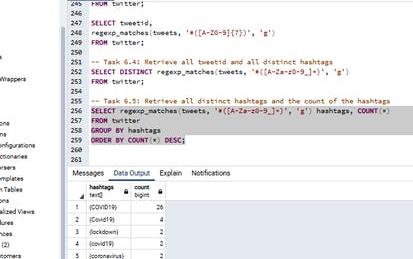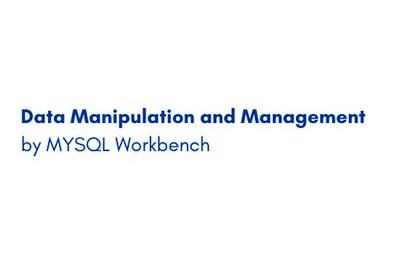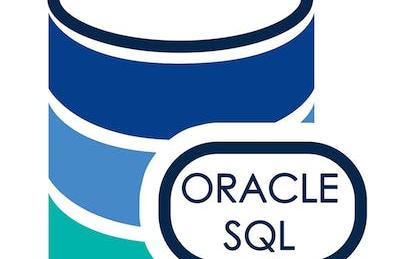

Our Courses

Introduction to Databases for Back-End Development
Back-end developers write applications that end-users use to interact with databases. Some common tasks that end-users carry out using these applications include storing, searching, extracting and manipulating data. Therefore, it’s essential that all back-end developers possess strong knowledge and experience with how databases work. In this course, you’ll receive an introduction to databases and explore the different ways in which they can be used to store and manage data. You’ll also learn to distinguish between different types of database management systems.
-
Course by

-
 Self Paced
Self Paced
-
 27 hours
27 hours
-
 English
English

Introduction to Regular Expressions in SQL
Welcome to this project-based course, Introduction to Regular Expressions in SQL. In this project, you will learn how to use SQL regular expressions extensively for pattern matching to query tables in a database. By the end of this 2-and-a-half-hour-long project, you will be able to use POSIX regular expressions together with meta (special) characters in the WHERE clause and the SELECT clause to retrieve the desired result from a database. In this project, we will move systematically by first revising the use of the LIKE and NOT LIKE operators in the WHERE clause.
-
Course by

-
 Self Paced
Self Paced
-
 3 hours
3 hours
-
 English
English

Manipulating Data with SQL
In this course you will learn to write the SQL code to manipulate the data in a relational database table. You’ll begin by populating the table with data. Since a database and its tables are designed and built to be repositories of data, getting the data into the tables is a critical activity in the building of a working database. When building a new home, the real test of your design comes when the furniture and family move in.
-
Course by

-
 Self Paced
Self Paced
-
 2 hours
2 hours
-
 English
English

Data Manipulation and Management using MYSQL Workbench
By the end of this project, you will be able to manage data efficiently in a specific database using MYSQL Workbench. You will be able to select data from tables from your database and use keywords in select statements such as LIMIT and Top. You will be able to update the data and filter them using where statements, and also apply conditions with different ways and keywords such as like, and, or, and between.
-
Course by

-
 Self Paced
Self Paced
-
 3 hours
3 hours
-
 English
English

MySQL Tutorial
Enhance your web development skills by starting with the W3Schools MySQL tutorial. MySQL is a widely-used, open-source relational database management system that is suitable for both small and large applications. The self-paced course includes text-based modules, interactive examples, and exercises to test your understanding as you progress. W3schools is the world's leading web developer learning site, and its tutorials have been used by millions of learners worldwide.
-
Course by

-
 Self Paced
Self Paced
-
 17 hours
17 hours
-
 English
English

Database Structures and Management with MySQL
Develop a working knowledge of the MySQL database management system (DBMS). Gain DBMS skills such as data creation, querying and manipulation. You’ll gain further experience with SQL statements, clauses and data types.
-
Course by

-
 Self Paced
Self Paced
-
 32 hours
32 hours
-
 English
English

MongoDB Tutorial
This tutorial is designed to introduce you to the MongoDB database management system. MongoDB is a NoSQL document database that stores data in flexible, JSON-like documents, making it easy to work with and integrate with web applications. In this tutorial, you will learn the basics of MongoDB, including how to install and set up MongoDB on your local machine, how to create databases and collections, and how to perform CRUD (Create, Read, Update, Delete) operations on data.
-
Course by

-
 Self Paced
Self Paced
-
 9 hours
9 hours
-
 English
English

SQL CASE Statements
Welcome to this project-based course, SQL CASE Statements. In this project, you will learn how to use SQL CASE statements to query tables in a database. By the end of this 2-hour long project, you will be able to write simple CASE statements to retrieve the desired result from a database. Then, we will move systematically to write more complex SQL CASE statements. Furthermore, we will see how to use the CASE clause together with aggregate functions, and SQL joins to get the desired result you want from tables in a database.
-
Course by

-
 Self Paced
Self Paced
-
 3 hours
3 hours
-
 English
English

The Web and Databases in Android
Learn how to work with web technologies and persistent data on Android applications even after you close or restart an app. There is a focus on web communication and developer tools and you will discover how Kotlin applications communicate over the web. You’ll learn how data formats and web protocols work in relation to Kotlin apps. Furthermore, you will practice applying asynchronous programming techniques using Kotlin. Learn the core functionality and uses of the SQLite database management system (DBMS).
-
Course by

-
 Self Paced
Self Paced
-
 English
English

Creating Database Tables with SQL
In this course you will experience the process of defining, creating, and managing relational database tables using the SQL language. Tables are used as the containers for the data in a database. As such, the structure, or makeup, of each table in a relational database is critical, since it must be designed and created specifically to meet the needs of the data it will contain. The table’s structure indicates which pieces of data are stored in a table, as well as the type and size of each piece of data.
-
Course by

-
 Self Paced
Self Paced
-
 2 hours
2 hours
-
 English
English

SQL Mathematical Functions
Welcome to this project-based course, SQL Mathematical Functions. In this project, you will learn how to use SQL Mathematical Functions to manipulate tables in a database. By the end of this 2-hour-long project, you will be able to use different Mathematical Functions to retrieve the desired result from a database. In this project, you will learn how to use SQL Mathematical Functions like CEIL(), FLOOR(), RANDOM(), SETSEED(), ROUND(), TRUNC(), SQRT(), CBRT(), and POWER() to manipulate data in the employees database.
-
Course by

-
 Self Paced
Self Paced
-
 2 hours
2 hours
-
 English
English

Exam Prep DP-300: Azure Database Administrator Associate
Database administration is one of the basic necessities of every enterprise. The growth of cloud and On-premises relational databases continues to create the need for professional database administrators. Therefore, an updated certification such as DP-300 could open up favorable options for employment of database administrators. The Azure database administrator implements and manages the operational aspects of cloud-native and hybrid data platform solutions built on SQL Server and SQL database services.
-
Course by

-
 Self Paced
Self Paced
-
 16 hours
16 hours
-
 English
English

Working with Data in Android
Learn how to work with web technologies and persistent data on Android applications even after you close or restart an app. There is a focus on web communication and developer tools and you will discover how Kotlin applications communicate over the web. You’ll learn how data formats and web protocols work in relation to Kotlin apps. Furthermore, you will practice applying asynchronous programming techniques using Kotlin. Learn the core functionality and uses of the SQLite database management system (DBMS).
-
Course by

-
 Self Paced
Self Paced
-
 27 hours
27 hours
-
 English
English

I/O-efficient algorithms
I/O-efficient algorithms, also known as external memory algorithms or cache-oblivious algorithms, are a class of algorithms designed to efficiently process data that is too large to fit entirely in the main memory (RAM) of a computer. These algorithms are particularly useful when dealing with massive datasets, such as those found in large-scale data processing, database management, and file systems. Operations on data become more expensive when the data item is located higher in the memory hierarchy.
-
Course by

-
 Self Paced
Self Paced
-
 10 hours
10 hours
-
 English
English

Create Relational Database Tables Using SQLiteStudio
In this project-based course, you will learn how to use the SQLiteStudio database management system to create a relational database, add tables to the database, and populate the tables.
-
Course by

-
 Self Paced
Self Paced
-
 3 hours
3 hours
-
 English
English

Working with Subqueries in SQL
Welcome to this project-based course, Working with Subqueries in SQL. In this project, you will learn how to use SQL subqueries extensively to query tables in a database. By the end of this 2-and-a-half-hour-long project, you will be able to use subqueries in the WHERE clause, FROM clause, and the SELECT clause to retrieve the desired result from a database. In this project, we will move systematically by first introducing the use of subqueries in the WHERE clause. Then, we will use subqueries in the FROM and SELECT clause by writing slightly complex queries for real-life applications.
-
Course by

-
 3 hours
3 hours
-
 English
English

MySQL with Information Technology
In this project you will explore how MySQL fits into information systems. You will become familiar with MySQL features as you explore database management system options and participate in hands-on exercises using MySQL Workbench to create and populate a table in a MySQL relational database. Note: This course works best for learners who are based in the North America region. We’re currently working on providing the same experience in other regions.
-
Course by

-
 Self Paced
Self Paced
-
 3 hours
3 hours
-
 English
English

IBM Data Warehouse Engineer
This Professional Certificate is intended to help you develop the job-ready skills and portfolio for an entry-level Business Intelligence (BI) or Data Warehousing Engineering position.
-
Course by

-
 Self Paced
Self Paced
-
 English
English

Meta Database Engineer
Want to get started in the world of database engineering? This program is taught by industry-recognized experts at Meta. You’ll learn the key skills required to create, manage and manipulate databases, as well as industry-standard programming languages and software such as SQL, Python, and Django used for supporting outstanding websites and apps like Facebook, Instagram and more. In this program, you’ll learn: Core techniques and methods to structure and manage databases. Advanced techniques to write database driven applications and advanced data modeling concepts.
-
Course by

-
 Self Paced
Self Paced
-
 English
English

The Web and Databases in iOS
In this course, you’ll move outside of the platform and begin working with integrations like web frameworks, tools and asynchronous programming techniques.
-
Course by

-
 Self Paced
Self Paced
-
 English
English

Oracle SQL Proficiency
This course is designed to help you continue learning about Oracle SQL and database management. We will look more closely at the Create, Alter, and Update commands, explore database relationships, and demonstrate how to use database views and SQL functions. It is recommended that you complete the first three courses of this specialization prior to this one.
-
Course by

-
 Self Paced
Self Paced
-
 6 hours
6 hours
-
 English
English

مهندس Meta لقواعد البيانات
Want to get started in the world of database engineering? This program is taught by industry-recognized experts at Meta.
-
Course by

-
 Self Paced
Self Paced
-
 Arabic
Arabic

Relational Database Administration (DBA)
Get started with Relational Database Administration and Database Management in this self-paced course! This course begins with an introduction to database management; you will learn about things like the Database Management Lifecycle, the roles of a Database Administrator (DBA) as well as database storage. You will then discover some of the activities, techniques, and best practices for managing a database. You will also learn about database optimization, including updating statistics, slow queries, types of indexes, and index creation and usage.
-
Course by

-
 Self Paced
Self Paced
-
 21 hours
21 hours
-
 English
English

Ingeniero en base de datos de Meta
Want to get started in the world of database engineering? This program is taught by industry-recognized experts at Meta.
-
Course by

-
 Self Paced
Self Paced
-
 Spanish
Spanish

Introduction to Databases
In this course, you will be introduced to databases and explore the modern ways in which they are used. Learn to distinguish between different types of database management systems then practice basic creation and data selection with the use of Structured Query Language (SQL) commands.
-
Course by

-
 Self Paced
Self Paced
-
 27 hours
27 hours
-
 English
English



